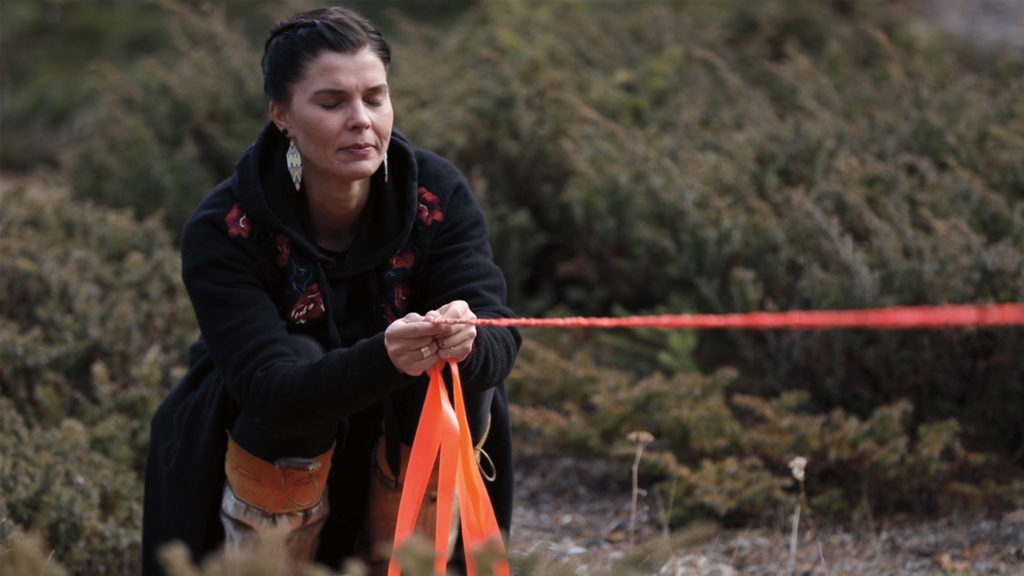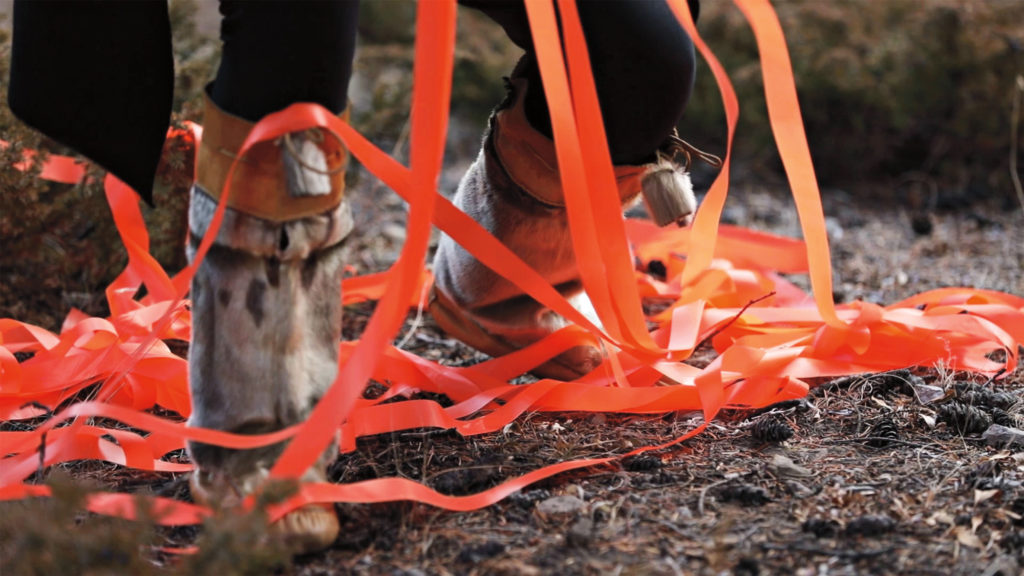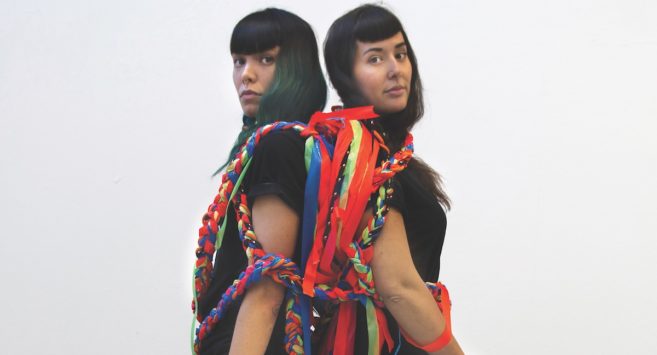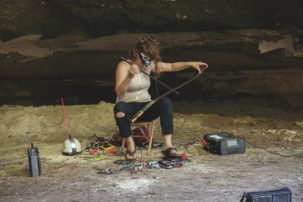In December 2017 in Banff National Park, Meagan Musseau, an interdisciplinary visual artist of Mi’kmaq and French ancestry from Elmastukwek within the Ktaqmkuk territory of Mi’kma’ki, staged a performative action titled when they poison the bogs we will still braid sweetgrass. In it, Musseau’s actions for the land demonstrated the importance of the environment and land-based practice in her work. Throughout her growing body of work, the land, as a teacher and as a source of connection to community and traditional knowledge, is present in various forms. when they poison the bogs… honoured the land while Musseau also worked to learn from it. She considered her performative action an offering of gratitude to the land on which she was a visitor: the actions and energy expended to produce the piece were a gift to the environment she inhabited. The memory of the work remains in the clearing where it occurred—as a humble offering, akin to what Nishnaabeg writer and poet Leanne Betasamosake Simpson has described as land-based knowing.
In her essay, “Land as Pedagogy: Nishnaabeg Intelligence and Rebellious Transformation,” Simpson advocates for the reclamation of land-based education by Indigenous peoples and identifies land-based pedagogy as central to nation-building and resistance. Centering Nishnaabeg stories, Simpson demonstrates the importance of learning from the land and on the land for Indigenous peoples coming to know themselves and their communities. While not in Mi’kma’ki, Musseau did what Simpson recommends: she took her body onto the earth to learn about her own practice. Musseau kinetically explored questions related to her identity as a Mi’kmaq woman, her role in her community and traditional practices. In when they poison the bogs…, Musseau worked to come to know herself on the land, trying to engage the “whole body intelligence” that Simpson advocates for in the process of learning.
Musseau’s work is an investigation of the complexity of Indigenous connection to land, and explores the body and ancestral memory, land-based pedagogy and the adaptation of new materials. Based in a methodology that centres collaboration and reciprocity—both of which are key to our individual practices—this text is inspired by my experiences of Musseau’s work; it is built from our conversations and includes her responses alongside my own.

Meagan Musseau, when they poison the bogs we will still braid sweetgrass, 2017. Digital video still from a land-based performance on Treaty 7 Territory, 10 minutes, 42 seconds. Courtesy the artist.

Meagan Musseau, when they poison the bogs we will still braid sweetgrass, 2017. Digital video still from a land-based performance on Treaty 7 Territory, 10 minutes, 42 seconds. Courtesy the artist.

Meagan Musseau, when they poison the bogs we will still braid sweetgrass, 2017. Digital video still from a land-based performance on Treaty 7 Territory, 10 minutes, 42 seconds. Courtesy the artist.

Meagan Musseau, when they poison the bogs we will still braid sweetgrass, 2017. Digital video still from a land-based performance on Treaty 7 Territory, 10 minutes, 42 seconds. Courtesy the artist.
Musseau described when they poison the bogs we will still braid sweetgrass as a vehicle for honouring land, creative forces and the territory upon which she was a visitor during a thematic residency at the Banff Centre. Addressing a multitude of issues arising in her larger practice, the performative action focused in particular on the desire to access ancestral Mi’kmaq knowledges through making. For Musseau, connecting with the environment and manufactured materials allowed her to assert her body as she engaged in the repetitive action of braiding. Her instinctive adaptation of new materials is an entry point to activate the genetic memory stored in her body.
I strengthen my Mi’kmaq worldview by living on ancestral lands, sharing and building in community, and creating artworks. This is my form of resistance to the continued dispossession of land, language and knowledge systems through the process of colonization and assimilation. By utilizing customary art practices and new media, such as beadwork, basketry, land-based action, video and installation, I explore notions of memory, language and the relationship between land and body, object and narrative. I am currently working with synthetic materials to represent the complicated nature of these relationships.
To view Musseau’s performative action, I walked through the forest. I moved through the trees and stepped over rocks searching for fluorescent orange flagging tape tied to branches, indicating the path. After following the trail, I met the artist in a clearing where she wrapped three strands of flagging tape around a spruce tree. The manufactured neon was jarring against the natural colours of the forest. I watched Musseau for more than an hour as she braided the three strands together, relying on the teachings she received by the women who taught her to braid, and the teachings about sweetgrass from Mi’kma’ki. Musseau struggled to braid the 18-yard strands of flagging tape as they whipped in the wind and tangled around her legs. As she braided the tape out from the tree, the bottom sections became entangled. I sympathized with her frustration and identified with her exertion. Musseau struggled to untangle and re-braid the tape; as she braided the top sections in a tight weave, the lower sections began to loosely braid themselves. She was surrounded in the clearing by juniper bushes, and, as the cold began to freeze her hands, the flagging tape cut her raw skin.
Her act of braiding tape recalled the practice of braiding sweetgrass, and hair. Musseau engaged her hands, feet and entire body in the braiding knowledge of her ancestral communities while a visitor to Treaty 7 land.
Musseau wove the three strands together while quietly repeating three Mi’kmaq words. She spoke the words quietly because they were not for those who witnessed to hear. Instead, the Mi’kmaq words were for the land and empowered Musseau as she worked. The words remain untranslated, partly to respect Musseau’s offering to the land, but also because English does not adequately communicate the worldviews embedded in Indigenous words. Privileging Indigenous language is a form of resistance, a refusal of colonial speech. As she worked, Musseau seemed to become overwhelmed not only by the physical demands of the actions, but also by the emotional and spiritual weight of her work. Nearing the end of the piece, the force of emotion took over and she began to cry. Focusing her sight on the neon plastic and pushing her body to continue, she eventually finished braiding, leaving the woven piece as a temporary offering, later to be gathered by the artist.
My feet, wrapped in auntie’s sealskin boots. They are planted on Sacred Buffalo Guardian Mountain. I wrap three 18-yard strands of neon orange flagging tape around a spruce tree. I couple the synthetic strands and prepare three threads to braid. Each thread represents a Mi’kmaw word for Creator and the energies of creation: kisu’lkw, tekweyu’lkw, jikeyulkw.
I turn my back to the tree and face the mountain, untangling yards of petroleum-based material twisted in juniper bushes and around my ankles. The weather is cold, I nestle my body to the ground for warmth. My hands crack, plastic slices my skin. My hands do not leave the braid––the umbilical cord connecting me to Wsitqamu’k.
Light in the sky shifts. I untangle, I braid, and I pray.
Braiding is a sacred act. Women taught me to braid.
Her act of braiding tape recalled the practice of braiding sweetgrass, and hair. Musseau engaged her hands, feet and entire body in the braiding knowledge of her ancestral communities while a visitor to Treaty 7 land. Braiding allows Musseau to use her body to connect with the land while engaging in questions of reclamation and identity. As in many Indigenous communities, braiding is connected to teachings about harvesting and relationships to land, family and community.
Using neon plastic instead of sweetgrass exposes the strained (and sometimes broken) thread of Indigenous knowledges, by laying bare the contemporary reality that many Indigenous peoples continue to search for ways to reconnect with the land and ancestral knowledges. Musseau explained that she didn’t know where to find sweetgrass, especially as a visitor on Treaty 7 Territory. She also reflected on the fact that she does not yet carry the knowledge needed to harvest those natural materials.
My lack of experience with natural materials demonstrates the influence of colonialism on my family, which affected the passing down of knowledge about traditional resources on Ktaqmkuk territory.
Musseau is learning how to harvest sweetgrass and other traditional materials, even if she appears disconnected from natural materials in the creation of her artworks. Like many Indigenous peoples, myself included, Musseau is in the process of reconnecting with certain ancestral knowledges as she works with community. While away from her home territories, the kinetic experience of braiding allows Musseau to continue her process of learning the teachings from Mi’kma’ki. Musseau has developed a practice of connecting to new territories by exploring performative actions with accessible materials, drawing from the teachings shared with her by mentors and communities.
The process of adapting non-traditional materials to engage in traditional practices continues elsewhere in her practice. For example, in her series Intergalactic L’nu Baskets (2017–18), she creates Mi’kmaq baskets using synthetic vinyl and neon flagging tape instead of ash wood, spruce root and sweetgrass harvested from the land. She learned how to create these basket forms with the support and guidance of multidisciplinary Mi’kmaq artist and basketmaker Ursula Johnson. As a mentor, Johnson played a significant role in helping Musseau find the confidence to explore customary weaving techniques using unconventional materials. The act of making baskets involves a knowledge system embedded in Mi’kma’ki. Musseau began to learn about that knowledge system with the support of her communities and, while she continues to learn, these human-made products allow her to connect with community and Indigenous ways of knowing.
By raising questions about the accessibility of materials, Musseau navigates the colonial boundaries of the land, and the legal systems that regulate resources. Due to the high volume of industrial resource extraction in Newfoundland, manufactured materials like petroleum products are, for Musseau, more available than natural ones. The colonial laws that govern Indigenous access to traditional territories and land are also limitations. Going onto the land to harvest resources can be intimidating, while fabricated materials are more accessible, allowing Musseau to continue to practice traditional skills.
In her material choices, Musseau juxtaposes industrial use of the land and Indigenous land-based knowledge. The artist subverts the familiar use of flagging tape by extractive industries, instead using it to mimic the natural material of sweetgrass. She also uses it to mark the land, bringing attention to it through stark contrasts—of colours and materiality, of natural and unnatural. In mimicking sweetgrass with flagging tape, she challenges the intended use of both materials to consider the relationship between extractive industries and Indigenous communities.
 Meagan Musseau, when they poison the bogs we will still braid sweetgrass, 2017. Digital video still from a land-based performance on Treaty 7 Territory, 10 minutes, 42 seconds. Courtesy the artist.
Meagan Musseau, when they poison the bogs we will still braid sweetgrass, 2017. Digital video still from a land-based performance on Treaty 7 Territory, 10 minutes, 42 seconds. Courtesy the artist.
Anishinaabe researcher Kathleen E. Absolon (Minogiizhigokwe) writes, in Kaandossiwin: How We Come To Know, “the body elements of Indigenous methodological tendencies include physical actions and creating movements.” Musseau’s focus on the importance of enacting Indigenous traditional practice rather than using traditional materials reflects these “body elements” of knowing. In our conversation, we spoke about the importance of Musseau’s hands in the creation of work. In much of her practice, she uses her hands to explore customary ways of making, but with synthetic material. This contrast, between the ancestral knowledge moving through her hands and her use of commercial materials, is felt, since the knowledge and adaptation present in our hands can be passed down genetically. Musseau’s hands move in the same ways as the hands of the women who came before her. And in the same way, her practice of weaving plastic into the same forms traditionally created by spruce roots, ash wood or sweetgrass is a knowledge embodied in the hands.

 Meagan Musseau, when they poison the bogs we will still braid sweetgrass, 2017. Digital video still from a land-based performance on Treaty 7 Territory, 10 minutes, 42 seconds. Courtesy the artist.
Meagan Musseau, when they poison the bogs we will still braid sweetgrass, 2017. Digital video still from a land-based performance on Treaty 7 Territory, 10 minutes, 42 seconds. Courtesy the artist.







